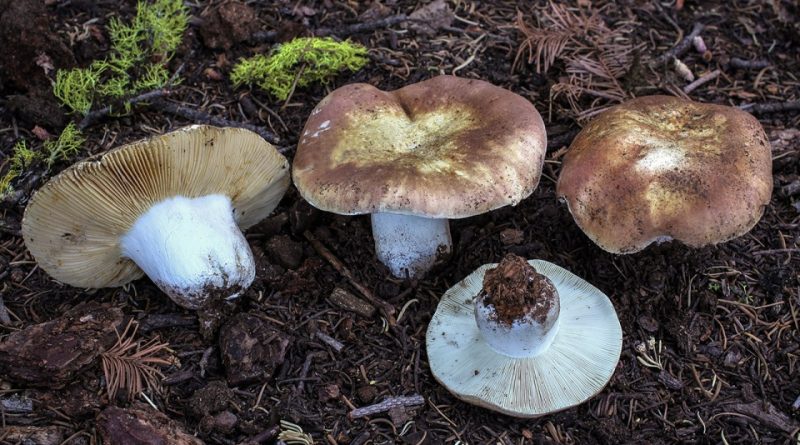Russula mustelina
Russula mustelina
The Russula mustelina (Russula mustelina Fr., 1838) is a basidiomycete fungus belonging to the Russulaceae family.
Systematics –
From the systematic point of view it belongs to the Eukaryota Domain, Fungi Kingdom, Phylum Basidiomycota, Class Basidiomycetes, Russulales Order, Russulaceae Family and therefore to the Genus Russula and to the R. mustelina Species.
Etymology –
The term Russula is the diminutive of red rússa, reddish for the frequent color of some species of this family. The specific epithet mustelina, comes from the Latin faina, for the color similar to the faina mantle.
Geographical Distribution and Habitat –
The Russula mustelina is a fungus that often grows sunken in the ground, in coniferous forests of the mountainous regions (fir and larch); its habitat is represented by acid soils and generally grows above 1000 m of altitude. This mushroom bears fruit in the period between late summer and autumn.
Recognition –
It is an easy to identify mushroom as it grows underground in the juvenile phase; the hat also has a color that recalls Boletus edulis, with a massive size, 8-14 cm in diameter and high specific weight, first rounded, then convex, finally flattened, sometimes a little depressed, very meaty, thick, firm and hard; on the cap there is also some soil that the fungus incorporates in the juvenile phase.
The cuticle is lardaceous in damp conditions and opaque when dry, very attached to the cap, separable up to a third, rather coarse, smooth, fibrillose, brown-ocher, more or less brown brown.
The margin is rigid, thick, smooth, long convoluted, then opens slowly, acute.
The lamellae are on average thick, thin, ventricose, sometimes forked and with few lamellulae, of cream color, sinuate and then free at the stem, anastomosed, lardaceous to the touch, whitish, straw-colored, light-cream, with the thread that is brownish stain in old age.
The stem is 4-11 X 2–4 cm, hard, robust, full for a long time, to then become spongy up to cavernous in adult age; it is often ventricose in the young specimens, then more or less cylindrical, white or slightly yellowish then stained with brownish, brown-yellow, with at the top, sometimes, pinkish reflections, with a tendency to get brown in old age.
The meat is white, very compact, firm, hard, yellowish under the cuticle, when cut it is lightly colored with ocher-brownish, with a fungal smell and a sweet, nutty flavor.
Under the microscope, spores of 7-11 x 6-7 µm can be seen, from sub-globose to ellipsoid, warty, slightly cross-linked and slightly connected, dirty cream pale.
The basidia are claviform, tetrasporic, 50–70 x 6-10 µm and the cystidia are fusiform, sometimes with an appendix, of 70–100 x 8–12 µm.
Cultivation –
Russula mustelina is not a cultivated mushroom.
Uses and Traditions –
This mushroom has characteristics that make it easy to identify, both for its growth, in the juvenile, buried phase, and because it recalls the Boletus edulis; it is of excellent yield and, besides, it is a very sought after species for the compactness of the meat and for the pleasant taste.
Among the similar species with which it could be confused we remember that, since it shares the habitat with some species of Boletus, often the collectors are misled by the colors of its hat, mistaking it above all for the Boletus edulis.
Within the same genre it can be confused with:
– Russula foetens and the like, which are distinguished however by the glutinous cuticle of the cap, by the nauseating smell (of bleach or bitter almonds), for the presence of a groove at the edge of the cap and for the somewhat unpleasant and acrid taste;
– Russula heterophylla f.ma adusta, which stands out because it grows under dry and temperate broad-leaved trees, for the lamellas forked at the stem and the dirty white;
– Russula ochroleuca, which has a more yellowish cap and slightly acrid flesh;
– Russula integra, which however has a more slender posture and decidedly yellow lamellae.
Preparation Mode –
The Russula mustelina, due to its flavor and characteristics, can be enjoyed raw in vegetable salads and excellent sautéed with garlic, extra virgin olive oil and parsley, with the hats stuffed with a dough made with minced meat or cheese, many aromas and chopped stems, since nothing is thrown away of this mushroom. It can be prepared with excellent linguine mare e monti. It can also be prepared as cutlets; after removing the stalk, sauté to flavor and then pass in the breadcrumbs and fry in the oven. Or bread with the egg and fry in plenty of oil. It can be cooked and then blended and reduced to a cream to be placed on slices of toasted bread and with melted cheese.
It also lends itself to oil preservation.
Guido Bissanti
Sources
– Wikipedia, the free encyclopedia.– Cetto B., 2008. The mushrooms from life, Saturnia, Trento.– Pignatti S., 1982. Flora of Italy, Edagricole, Bologna.– Conti F., Abbate G., Alessandrini A., Blasi C. (ed.), 2005. An annotated checklist of the Italian vascular flora, Palombi Editore.
Attention: Pharmaceutical applications and food uses are indicated for informational purposes only, do not in any way represent a medical prescription; therefore no responsibility is assumed for their use for curative, aesthetic or food purposes.


